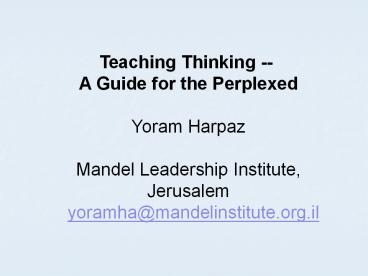Presentation: Teaching Thinking - A guide for the perplexed - PowerPoint PPT Presentation
1 / 18
Title:
Presentation: Teaching Thinking - A guide for the perplexed
Description:
Teaching Thinking -- A Guide for the Perplexed Yoram Harpaz Mandel Leadership Institute, Jerusalem yoramha_at_mandelinstitute.org.il Why teach thinking? – PowerPoint PPT presentation
Number of Views:208
Avg rating:3.0/5.0
Title: Presentation: Teaching Thinking - A guide for the perplexed
1
Teaching Thinking -- A Guide for the
Perplexed Yoram Harpaz Mandel Leadership
Institute, Jerusalem yoramha_at_mandelinstitute.org
.il
2
Why teach thinking? The explosion of knowledge
- Knowledge is expanding
- Knowledge is accessible
- Knowledge is relative
3
How teach thinking when...
There are an awful lot of theories around.
Robert Sternberg With so much
controversy in the air, its understandable that
only a few teachers and schools make the
attempt. -- David Perkins Mind Workers
Unite! -- Arthur Costa
4
Approaches to Teaching Thinking
- The Main Question what is the foundational
element of good thinking and how is it taught? - Skills Approach
- Dispositions Approach
- Understanding Approach
5
Some definitions
Skills means of thinking implemented rapidly and
precisely (e.g. heuristics, tools, organizers).
Neutral skills means of thinking that render
common cognitive processes more efficient (e.g.
classifying, grading, comparing, deciding,
etc.). Normative skills means of thinking that
create uncommon cognitive processes (e.g.
breaking patterns, devising problems, exposing
premises, discovering biases, etc.).
6
Some definitions
Disposition intellectual trait that is
conciously chosen and justified. Thinking
dispositions traits with direct impact on
thinking. Disposition to think to engage and
be engaged in thinking.
7
Some definitions
Understanding locating knowledge in relevant
and rich contexts and/or performance
intellectual moves with knowledge. Substantive
understanding understanding the substance of
thinking. Reflective understanding
understanding thinking or the conditions that
make it good thinking.
8
Patterns of teaching thinking
Teaching education through knowledge Skills
Impartation Disposition Cultivation Understan
ding Construction
9
The Approaches as Worldviews
Skills Good Thinker is efficient thinker
Dispositions Good Thinker is wise thinker
Understanding Good Thinker is learned thinker
10
The approaches as lenses
Thinking Shortfalls Skills faults (lack of
thinking skills or their faulty
application) Dispositions weaknesses (character
flaws or weak ego) Understanding
misunderstandings Metacognition Intelligence Tran
sfer
11
The Metaphorical Aspects The essence of metaphor
is understanding and experiencing one kind of
thing in terms of another. (Lakoff Johnson,
1980)
Skills thinking as a toolbox
Dispositions thinking as deep currents
Understanding thinking as a net
12
The practical aspect the approaches in school
Skills standard deviation taming
Dispositions standard deviation preaching
Understandings standard deviation lecturing
13
The Understanding Approach The Dispositions Approach The Skills Approach Approaches Characteristics
Understanding Dispositions Skills Foundational element
Construction Cultivation Impartation Patterns of teaching
Learned thinker Wise thinker Efficient thinker Ideologies "the good thinker"
Net Deep currents Toolbox Metaphors for thinking
Lecturing Preaching Taming Standard deviation
David Perkins Howard Gardner, Teaching for Understanding Arthur Costa, Habits of Mind Edward De Bono, CoRT Examples
14
Two Essential Questions
1. What to believe why three?
2. What to do which approach is best?
15
1. Three elements of good thinking correspond to
three components of thinking Thinking skills
Processes of thinking
Thinking disposition Qualities
of thinking Understanding
Contents of thinking
16
2. Teach skills and dispositions within the
understanding approach and the pattern of
construction.
17
The Understanding Approach The Dispositions Approach The Skills Approach Approaches Characteristics
Perkins - Understanding performances ? Gardner - Understanding in the disciplines ? Wiske - Teaching for understanding ? Wiggins McTighe - Understanding by design ? Paul - Critical thinking in the strong sense ? McPeck - The reflective critical thinker ? Brown - Community of learners ? Smith - Understanding as good thinking ? Brooks Brooks - Constructivist instruction ? Lipman - Philosophy for children ? Harpaz Lefstein - Community of thinking Perkins - Dispositions theory of thinking ? Tishman - Thinking dispositions ? Costa - Habits of mind ? Baron -Theory of rationality ? Langer Mindfulness ? Barrel Thoughtfulness ? Facione - Critical thinking dispositions ? Passmore - Critical thinking as a character trait ? Siegel - The spirit of the critical thinker ? Sternberg - Successful intelligence ? Golman - Emotional Intelligence ? Lipman - Philosophy for children De Bono CoRT ? Ennis - Taxonomy of critical chinking ? Beyer - Direct teaching of thinking ? Perkins - Thinking frames ? Perkins Swartz - Graphic organizers ? Swartz Parks Infusion ? Sternberg - Intelligence implied ? Treffinger, Isaksen Dorval - Creative problem polving ? Johnson Blair - Informal logic ? Chaffee - thinking critically ? Whimbey Lochhead - Problem solving ? Feuerstein. - Instrumental Enrichment ? Lipman - Philosophy for children Theories, programs, ideas - examples
18
The Understanding Approach The Dispositions Approach The Skills Approach Approaches Characteristics
Understanding The ability to locate a concept in a context of other concepts, to implement concepts in new contexts and perform thinking processes with knowledge. Dispositions Motivation for good thinking which is formed by reasonable choices. Skills Thinking tools used efficiently - quickly and precisely - in given circumstances. The foundational element of good thinking
Substantive understanding Reflective understanding Thinking dispositions Disposition to think Neutral skills Normative skills Types of foundational elements
The pattern of construction The pattern of cultivation The pattern of impartation Patterns of teaching
Learned thinker Wise thinker Efficient thinker Ideologies "the good thinker"
Misunderstandings Weaknesses Faults Typical Thinking shortfalls
Metacognition is understanding Metacognition is disposition Metacognition is skill Meta-cognition
Intelligence is constituted of understandings Intelligence is constituted of dispositions Intelligence is constituted of skills Intelligence
Skill and disposition are included in understanding Skill and understanding are included in disposition Disposition and understanding are included in skill Attempt at reductionism
Net Deep currents Toolbox Metaphors for thinking
Lecturing Preaching Taming Standard deviation
Give the child knowledge of the fishing field! Give the child bait! Give the child a fishing rod! Slogan

